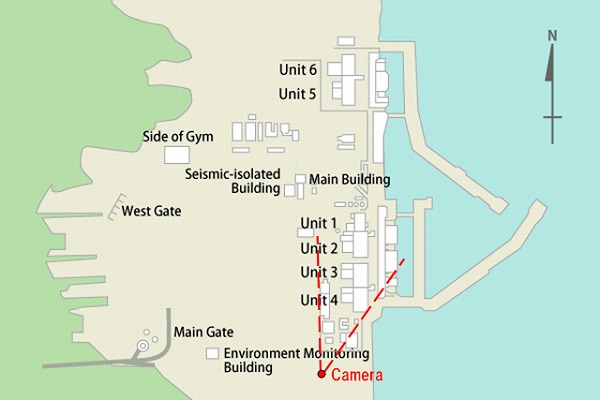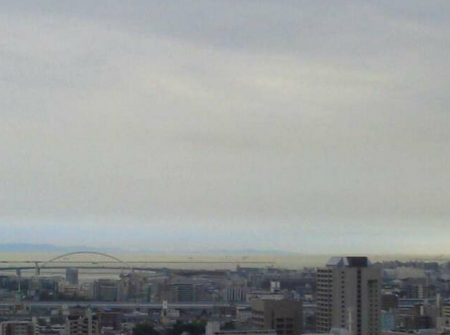http://www.popularmechanics.com/science/environment/natural-disasters/tiny-electric-signals-could-predict-earthquakes-or-bridge-failures-9617140?click=pm_latest

Considering these potential applications, the discovery comes from an unexpected place. Physicist Troy Shinbrot normally studies the ways in which pharmaceutical powders stick together during the manufacturing process. But one day, inspired by historical reports of earthquake lights, Shinbrot decided on a whim to conduct a small experiment with some equipment around the lab. He and his students added a few scoops of finely ground Tylenol into a slowly spinning cylinder, but didn't expect to observe anything interesting.
Like laundry in a washing machine, the powder stuck to the sides of the spinning cylinder and built up there. But after reaching a certain height, the powder would crack and tumble back down to the bottom. (Imagine trying to build a mountain out of flour or some other powdery substance. When the sides get too steep, it comes crumbling down.)
Inside the tumbler, the mini avalanches created voltages higher than 100 volts. That wasn't altogether surprising. Solids such as glass, rock, and ice also produce electrical signals when they break. What was surprising was that the voltage spike sometimes preceded the avalanche by as much as 5 seconds.
"It was shocking," Shinbrot says. "We don't have any explanation for this." He and his team repeated the experiments using different types of containers and powders, including bleached and unbleached flour, plaster, and mortar. But they kept coming up with the same results. "Somehow, pulling powders apart seems to produce a voltage. There has to be something happening on the microscopic level that produces these voltages."
Scott Waitukaitis, a doctoral candidate who studies electrification in granular systems at the University of Chicago, says he suspects that the spark is created when electrically charged particles are pulled apart. Waitukaitis was impressed by how reliably the signal precedes the avalanche. "If we can predict when an avalanche will occur, we may be able to get a little bit of warning before an event like an earthquake. I think that's really big." Although a 5 second heads-up is clearly not enough time to evacuate people from an earthquake zone, Waitukaitis says that with smart grid technologies, perhaps it would be enough warning to turn off sensitive technologies that might explode or cause fires during the quake.
And because ceramic turbines and concrete bridges are also composed of fine particles, a voltage spike might also precede cracking in these structures. Shinbrot says that years or decades from now, a better understanding of the particles' electrical interactions may one day enable technologies that predict breakages before they cause catastrophic damage.
For now, Shinbrot has many more questions: Is there a voltage precursor when using larger particles such as sand or sugar? What happens when the particle sizes are mixed, like they are in the Earth's crust? And does the phenomenon differ across larger scales?
"This is a new effect, and it's very strange," Shinbrot says. "So the big question is: What on earth is going on? Either we've made a mistake, or there's something fundamental and new going on."
and.....
<Translate>

 TEPCO's live cam of Fukushima I Nuclear Power Plant is set up near the Seismic Isolation Building near the Reactor 1 building, looking toward the Reactor 4 building and the Common Spent Fuel Pool (i.e. looking southeast).
TEPCO's live cam of Fukushima I Nuclear Power Plant is set up near the Seismic Isolation Building near the Reactor 1 building, looking toward the Reactor 4 building and the Common Spent Fuel Pool (i.e. looking southeast).
The worker who's been tweeting from the plant since March 2011 says in one of his tweets yesterday (about how decisions are made on project costs, etc) that there is another camera from the direction of Reactor 4:
Tiny Electric Signals Could Predict Earthquakes or Bridge Failures
In the final seconds before a powdery material forms an avalanche or cracks, it emits an electrical signal. New studies of this strange effect could help scientists predict real-life avalanches and earthquakes.
By Sarah Fecht

Snapshot of cracks in sheared powder bed, measured 1-cm away from crack. Cracks open and close when the bed is sheared left or right, and whenever a crack opens, the voltage drops by about 100 V.
Shinbrot et. al. / PNAS
In the early hours of January 17, 1995, fishermen were already hard at work in Japan's Osaka Bay when they noticed a strange orange light shoot across the distant shore. They watched as the luminous object, 100 meters tall, swept left-to-right across the ground until it crashed into a nearby mountain range. Then lightning struck from the sky. A few seconds later, the water beneath the boats began sloshing—a magnitude 6.8 earthquake had just struck.
What those fishermen were feeling was the Great Hanshin earthquake, and what they were seeing was "earthquake lights." These balls and columns of light that seem to co-occur with seismic activity have been recorded in thousands of anecdotes. They've been recorded scientifically too, but they still defy explanation.
Scientists from Rutgers University may have stumbled upon an answer. They discovered that clumps of fine particles emit electrical voltages just before they crack. A better understanding of this unexpected electrostatic property may one day help to predict earthquakes, avalanches, mine shaft collapses, and bridge failures.
What those fishermen were feeling was the Great Hanshin earthquake, and what they were seeing was "earthquake lights." These balls and columns of light that seem to co-occur with seismic activity have been recorded in thousands of anecdotes. They've been recorded scientifically too, but they still defy explanation.
Scientists from Rutgers University may have stumbled upon an answer. They discovered that clumps of fine particles emit electrical voltages just before they crack. A better understanding of this unexpected electrostatic property may one day help to predict earthquakes, avalanches, mine shaft collapses, and bridge failures.
Considering these potential applications, the discovery comes from an unexpected place. Physicist Troy Shinbrot normally studies the ways in which pharmaceutical powders stick together during the manufacturing process. But one day, inspired by historical reports of earthquake lights, Shinbrot decided on a whim to conduct a small experiment with some equipment around the lab. He and his students added a few scoops of finely ground Tylenol into a slowly spinning cylinder, but didn't expect to observe anything interesting.
Like laundry in a washing machine, the powder stuck to the sides of the spinning cylinder and built up there. But after reaching a certain height, the powder would crack and tumble back down to the bottom. (Imagine trying to build a mountain out of flour or some other powdery substance. When the sides get too steep, it comes crumbling down.)
Inside the tumbler, the mini avalanches created voltages higher than 100 volts. That wasn't altogether surprising. Solids such as glass, rock, and ice also produce electrical signals when they break. What was surprising was that the voltage spike sometimes preceded the avalanche by as much as 5 seconds.
"It was shocking," Shinbrot says. "We don't have any explanation for this." He and his team repeated the experiments using different types of containers and powders, including bleached and unbleached flour, plaster, and mortar. But they kept coming up with the same results. "Somehow, pulling powders apart seems to produce a voltage. There has to be something happening on the microscopic level that produces these voltages."
Scott Waitukaitis, a doctoral candidate who studies electrification in granular systems at the University of Chicago, says he suspects that the spark is created when electrically charged particles are pulled apart. Waitukaitis was impressed by how reliably the signal precedes the avalanche. "If we can predict when an avalanche will occur, we may be able to get a little bit of warning before an event like an earthquake. I think that's really big." Although a 5 second heads-up is clearly not enough time to evacuate people from an earthquake zone, Waitukaitis says that with smart grid technologies, perhaps it would be enough warning to turn off sensitive technologies that might explode or cause fires during the quake.
And because ceramic turbines and concrete bridges are also composed of fine particles, a voltage spike might also precede cracking in these structures. Shinbrot says that years or decades from now, a better understanding of the particles' electrical interactions may one day enable technologies that predict breakages before they cause catastrophic damage.
For now, Shinbrot has many more questions: Is there a voltage precursor when using larger particles such as sand or sugar? What happens when the particle sizes are mixed, like they are in the Earth's crust? And does the phenomenon differ across larger scales?
"This is a new effect, and it's very strange," Shinbrot says. "So the big question is: What on earth is going on? Either we've made a mistake, or there's something fundamental and new going on."
and.....
http://fukushima-diary.com/2012/06/osaka-bay-looking-yellow/
Osaka bay looking yellow
Posted by Mochizuki on June 13th, 2012 · 16 Comments
At this moment, people in Osaka and Kobe are tweeting the color of Osaka bay looks strange.
From the picture, it looks pale yellow.
From local citizens, it became strange color before The great Hanshin earthquake (1995) as well. They might need to stay informed just in case.
<Translate>
Moving from parents house to Mikage. Osaka bay looked yellowish when I saw from an eminence. am afraid it’s a sign ~ ?
<End>
<Translate>
Now I received a message from my friend in Kobe, says the color of Osaka bay is strange. Earthquake ?
<End>
<Translate>
They say the color of Osaka bay is strange.. What kind of a phenomena is it ? I didn’t see it myself. Someone from Sumaku Kobe messaged “I haven’t seen it before.”.
and on the same subject.....
http://theextinctionprotocol.wordpress.com/2012/06/13/omen-waters-near-osaka-bay-japan-turn-pale-yellow/
Omen? Waters near Osaka bay Japan turn pale yellow
June 13, 2012 – JAPAN - At this moment, people in Osaka and Kobe are tweeting the color of Osaka bay looks strange. From the picture, it looks pale yellow. One follower on the site tweeted: “Moving from parents house to Mikage. Osaka bay looked yellowish when I saw from an eminence. Am afraid it’s a sign.” From local citizens, it became strange color before the great Hanshin earthquake (1995) as well. They might need to stay informed just in case. –Fukushima Diary
Fish kill: The region is near the area of a recent sardine mega-fish kill. In May of this year, Japanese seismologist warned of the dangers of a tripple-earthquake strike in the area: “If three earthquakes simultaneously occurred along the Nankai Trough located in the seabed off central to western Japan, high-rise buildings in Osaka would be shaken by long-period ground motion five times stronger than that in the Great East Japan Earthquake, researchers have predicted. A group of researchers with the University of Tokyo made the announcement on May 21 at the Japan Geoscience Union Meeting, currently under way in Chiba. The group also speculates that, if the three temblors — the Tokai, Tonankai and Nankai quakes — took place together, high-rise buildings in Tokyo would be shaken by long-period ground motion twice to three times stronger than that in the Great East Japan Earthquake, which struck northeast Japan on March 11, 2011. The long-period ground motion will be stronger in the Tokai-Tonankai-Nankai earthquake because seismic tremors will be amplified by soft rock and stone deposited along the plate boundaries in the Nankai Trough, according to the researchers. The announcement is expected to prompt authorities to step up measures to minimize possible effects on urban areas, which host skyscrapers. In their study, the group predicted the intensity of long-period ground motion in the event that magnitude-8.7 triple earthquakes took place along the Nankai Trough simultaneously. In case of seismic movements with a cycle of six seconds, the seismic velocity would be 250 centimeters per second in Osaka’s bay area — five times that in the Great East Japan Earthquake — and 110 to 165 centimeters per second in central Tokyo. The tremors in both cities would also last at least twice as long as the March 11 quake, according to the researchers.” -DU

contribution by Louise M.
http://enenews.com/cover-over-reactor-1-building-is-only-cosmetic-built-to-keep-webcam-from-filming-badly-damaged-building-has-nothing-to-do-with-preventing-radioactive-materials-from-escaping
Tweet by Fukushima worker @Happy11311 summarized by EXSKF:
[...] the fabric cover over the Reactor 1 building is only cosmetic, and nothing to do with preventing the radioactive materials from escaping. There was a talk, presumably from the contractors, to build a more permanent structure (more like the one they are building for Reactor 4) but that was shot down by TEPCO over the cost concerns. They wanted the badly damaged Reactor 1 building out of sight of the live cam, he says.
and.....
http://ex-skf.blogspot.com/2012/06/there-is-another-camera-from-reactor-4.html
WEDNESDAY, JUNE 13, 2012
There Is Another Camera from Reactor 4 Direction, Says a Worker at #Fukushima I Nuke Plant
 TEPCO's live cam of Fukushima I Nuclear Power Plant is set up near the Seismic Isolation Building near the Reactor 1 building, looking toward the Reactor 4 building and the Common Spent Fuel Pool (i.e. looking southeast).
TEPCO's live cam of Fukushima I Nuclear Power Plant is set up near the Seismic Isolation Building near the Reactor 1 building, looking toward the Reactor 4 building and the Common Spent Fuel Pool (i.e. looking southeast).The worker who's been tweeting from the plant since March 2011 says in one of his tweets yesterday (about how decisions are made on project costs, etc) that there is another camera from the direction of Reactor 4:
ホントはいま4号機側にカメラあるでし。4号機南側のスタック上部にカメラがあって現場はそれ見てるでし。
In fact, there is a camera right now from the Reactor 4 side. There is a camera on the upper part of the [exhaust] stack on the south side of Reactor 4, and we've been looking [at the images from that camera].
His tweet is in response to a comment about a talk of moving the live cam to a different location, possibly to the Reactor 4 side.
I think he said last year (fairly early in the crisis) that there were many monitoring cameras throughout the plant but TEPCO didn't talk about them. TEPCO's spokesman Matsumoto admitted to the existence of such cameras in a press conference several month ago (I think), and said he would look into it. (He must be still looking into it.)
The worker also alleges that the fabric cover over the Reactor 1 building is only cosmetic, and nothing to do with preventing the radioactive materials from escaping. There was a talk, presumably from the contractors, to build a more permanent structure (more like the one they are building for Reactor 4) but that was shot down by TEPCO over the cost concerns. They wanted the badly damaged Reactor 1 building out of sight of the live cam, he says.
I think he said last year (fairly early in the crisis) that there were many monitoring cameras throughout the plant but TEPCO didn't talk about them. TEPCO's spokesman Matsumoto admitted to the existence of such cameras in a press conference several month ago (I think), and said he would look into it. (He must be still looking into it.)
The worker also alleges that the fabric cover over the Reactor 1 building is only cosmetic, and nothing to do with preventing the radioactive materials from escaping. There was a talk, presumably from the contractors, to build a more permanent structure (more like the one they are building for Reactor 4) but that was shot down by TEPCO over the cost concerns. They wanted the badly damaged Reactor 1 building out of sight of the live cam, he says.





No comments:
Post a Comment